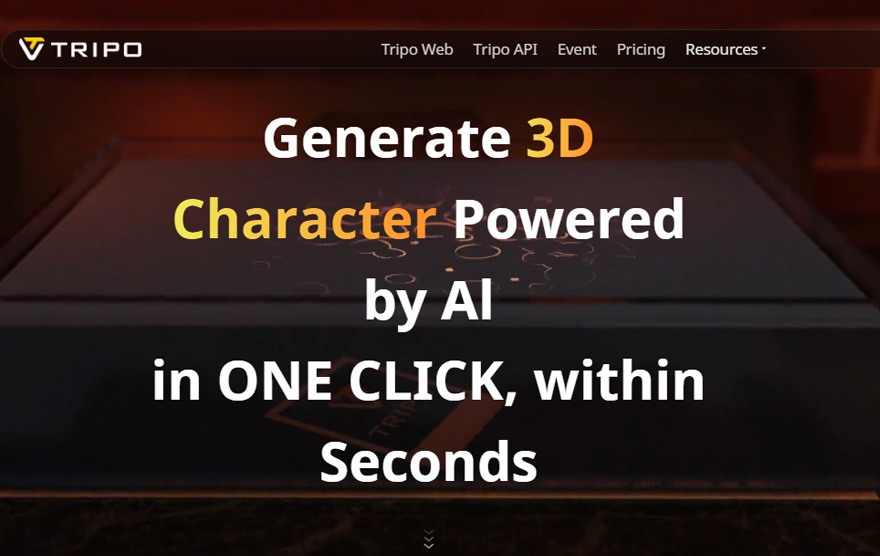Overview
Tripo3d revolutionizes 3D content creation by blending advanced AI technologies like NLP, Computer Vision, and Generative AI into a seamless workflow. Whether you’re a designer, developer, or creative professional, this tool empowers you to generate high-quality 3D models effortlessly—from text prompts, single images, multi-view inputs, or even simple doodles. Beyond modeling, Tripo3d simplifies animation with auto-rigging for humanoid characters and avatars, while its versatile export options (glb, fbx, obj, and more) ensure compatibility with industry-standard pipelines. With upcoming features like AI-generated interactive 3D environments and a library of 100+ scenario templates for video generation, it’s a dynamic solution for research, analysis, and beyond.
Tailored for innovators who demand precision and speed, Tripo3d bridges the gap between imagination and execution. Its ability to transform abstract ideas or rough sketches into polished 3D assets makes it indispensable for prototyping, virtual world-building, and data visualization. The tool’s focus on automation—like auto-rigging and template-driven workflows—frees users to focus on creativity rather than technical hurdles. Whether you’re analyzing spatial data, crafting immersive environments, or exploring generative design, Tripo3d delivers a future-forward platform where efficiency meets limitless potential.
Key Features
- Generate 3D models from text/single image/multi-view images/doodles
- Auto-rigging for humanoid characters and avatars
- Export models in glb, fbx, obj, usd, stl, schematic formats
- AI-generated interactive 3D environments (coming soon)
- 100+ 3D scenario templates for video generation
- Detailed geometry and PBR materials in generated models
- Supports game/3D printing/MR/metaverse/product design
- Open-source TripoSR model available on GitHub
Use Cases
3D Model Reconstruction from Images
Tripo3D enables researchers to reconstruct accurate 3D models from 2D images, streamlining the process of digitizing physical objects. By leveraging advanced AI algorithms, the tool analyzes multiple images of an object and generates a detailed 3D representation, which can be used for further analysis, simulations, or archival purposes. This is particularly valuable in fields like archaeology, forensics, and engineering, where precise 3D models are essential for research and documentation.
Virtual Prototyping and Design Validation
Tripo3D accelerates the prototyping phase by allowing researchers and designers to create and validate 3D models virtually. The tool’s AI-driven analysis capabilities help identify potential design flaws, optimize geometries, and simulate real-world conditions. This reduces the need for physical prototypes, saving time and resources in industries such as automotive, aerospace, and product design, where iterative testing is critical.
Medical Imaging and Anatomical Analysis
Tripo3D enhances medical research by converting 2D scans (such as MRI or CT images) into interactive 3D models. These models enable detailed anatomical analysis, surgical planning, and educational demonstrations. The tool’s precision and ability to highlight subtle structures make it invaluable for healthcare professionals and researchers studying complex physiological systems or developing new treatment methodologies.
Cultural Heritage Preservation
Tripo3D aids in the preservation and study of cultural artifacts by creating high-fidelity 3D models of historical objects, monuments, and sites. Researchers can analyze these models without risking damage to the originals, and the digital replicas can be shared globally for educational or restoration purposes. This use case is particularly relevant for museums, universities, and conservation organizations working to document and protect cultural heritage.
Geospatial and Environmental Research
Tripo3D supports geospatial analysis by transforming aerial or satellite imagery into 3D terrain models. Researchers can study landforms, monitor environmental changes, and simulate natural phenomena like erosion or flooding. The tool’s ability to process large datasets quickly makes it ideal for climatologists, geologists, and urban planners who rely on accurate 3D representations for their studies.
Target Audience & Industries
Target Audience
Tripo3d is designed for businesses and professionals who require high-quality 3D modeling and visualization to enhance their operations, marketing, and product development. This includes entrepreneurs, designers, architects, engineers, and marketing teams who need efficient, scalable, and cost-effective solutions to create immersive 3D content. The tool benefits them by streamlining workflows, reducing production time, and enabling photorealistic renderings that improve customer engagement and decision-making.
Target Industries
Industries that would benefit most from Tripo3d include architecture and real estate for virtual tours and property visualization, e-commerce for 3D product displays, gaming and entertainment for asset creation, manufacturing for prototyping and design validation, and education for interactive learning materials. These sectors leverage Tripo3d to enhance visualization, improve customer experiences, and accelerate innovation.
Evaluation and Review
Advantages
- Versatile 3D Model Generation: Create 3D models from various inputs like text, single images, multi-view images, or doodles, streamlining the modeling process.
- Auto-Rigging for Humanoid Characters: Save time with automated rigging for avatars and humanoid models, ideal for animation and game development.
- Multi-Format Export Support: Export models in popular formats (glb, fbx, obj, etc.), ensuring compatibility with game engines, 3D printing, and other applications.
- AI-Generated Interactive Environments: Leverage upcoming features to build dynamic 3D environments, enhancing immersive experiences for metaverse or VR projects.
- High-Quality Outputs: Generate models with detailed geometry and PBR materials, suitable for professional-grade product design or visualizations.
- Open-Source Accessibility: Utilize the open-source TripoSR model for customization and research, fostering innovation in AI-driven 3D modeling.
Limitations
- Quality variability: Generated 3D models may vary in quality depending on input complexity or ambiguity in text/image prompts.
- Hardware requirements: Advanced features like auto-rigging or environment generation may require higher-end hardware for optimal performance.
- Learning curve: Users unfamiliar with 3D workflows may need time to master exporting and integrating models into their pipelines.
- Limited customization: AI-generated models may lack fine-grained control compared to manually crafted 3D assets.
Other Information
Domain Info
Created at: 2023-10-27
Expires at:
Interest over time
Worldwide. Past 90 days. Web Search.

